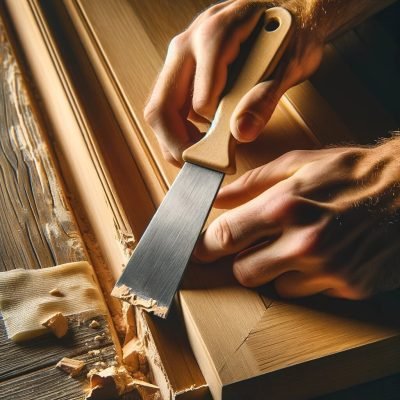Hairline cracks in wood doors can be a common issue, especially in homes that experience significant changes in humidity or temperature.
These small cracks may not compromise the structural integrity of the door, but they can detract from its appearance and may lead to bigger problems if not addressed.
Fortunately, fixing hairline cracks in wood doors is a manageable DIY project that can restore the beauty and longevity of your door.
This guide will walk you through the steps to effectively repair these cracks, ensuring your door looks as good as new.
Key Takeaways:
- Hairline cracks in wood doors can be effectively repaired with the right materials and techniques.
- Preparing the crack properly before applying any filler is crucial for a seamless repair.
- Choosing the right type of filler based on the door’s finish and the size of the crack ensures a durable repair.
- Sanding and finishing the repaired area helps blend the repair into the rest of the door.
Understanding Hairline Cracks in Wood Doors
Causes of Hairline Cracks
Hairline cracks in wood doors can occur for several reasons. Fluctuations in humidity and temperature are the most common culprits, causing the wood to expand and contract. Over time, this movement can create small cracks. Other causes include the natural aging process of wood, impact damage, or stress on the door’s structure.
Identifying the Severity of the Crack
Not all cracks require the same level of intervention. It’s important to assess the severity of the crack before deciding on a repair method. Hairline cracks are narrow and shallow, typically not affecting the door’s functionality, whereas deeper or wider cracks may require more extensive repairs.
Preparing the Crack for Repair

Cleaning the Crack
The first step in repairing a hairline crack is to ensure it’s clean and free from debris. Use a vacuum with a brush attachment or a can of compressed air to remove dust and particles. This preparation ensures the filler adheres properly to the wood.
Widening the Crack (If Necessary)
In some cases, slightly widening the crack with a razor blade or fine chisel can help the filler bond better to the wood. This step should be done with care to avoid further damage to the door.
Choosing the Right Filler
Types of Fillers
There are several types of fillers suitable for repairing hairline cracks in wood doors, including:
- Wood putty: Best for painted doors, as it’s easy to sand and paint over.
- Wood filler: Ideal for stained doors, as it can be tinted to match the wood grain.
- Epoxy: A strong, durable option for larger cracks, but requires precise mixing and application.
Matching the Filler to the Door’s Finish
Selecting a filler that matches the door’s finish is crucial for a seamless repair. For stained doors, choose a filler that can be tinted to match the wood. For painted doors, any filler that can be sanded smooth and painted over will work.
Repairing the Crack
Applying the Filler
Using a putty knife, apply the filler into the crack, ensuring it’s completely filled. Overfilling slightly is recommended, as the filler will shrink slightly as it dries.
Sanding the Filled Crack
Once the filler has dried completely, sand the area smooth with fine-grit sandpaper. The goal is to make the repair flush with the rest of the door’s surface, without removing too much of the surrounding finish.
Finishing the Repair
The final step is to apply paint or stain to the repaired area, matching the door’s original finish. For best results, apply a primer before painting, or seal the area with a clear finish after staining.

Maintenance Tips to Prevent Future Cracks
- Control Humidity: Use a dehumidifier or humidifier to maintain stable humidity levels in your home.
- Protect from Direct Sunlight: Use curtains or blinds to minimize direct sunlight on the door, which can cause the wood to dry out and crack.
- Regular Maintenance: Periodically inspect your door for signs of wear and address any issues promptly to prevent further damage.
Relevant Resources
YouTube Tutorials
By following these steps and tips, you can effectively repair hairline cracks in your wood door, restoring its appearance and extending its lifespan. Whether the crack is a result of environmental factors, aging, or impact, the right approach to repair can make your door look as good as new.
Continuing from where we left off, after successfully repairing the hairline crack in your wood door and ensuring it blends seamlessly with the original finish, it’s essential to focus on long-term maintenance and prevention strategies. Additionally, understanding the frequently asked questions about this repair process can provide further clarity and assistance.
Long-Term Maintenance and Prevention
Maintaining your wood door and preventing future cracks requires regular attention and care. Here are some additional tips to keep your door in top condition:
Regular Inspection and Touch-Ups
- Periodically inspect your door for any signs of wear or damage. Early detection of issues like small cracks or peeling finish can prevent more significant problems down the line.
- Perform touch-ups as needed. If you notice small areas where the finish is wearing away or minor damage, addressing these spots promptly can keep your door looking great and prevent further damage.
Protecting the Door from Extreme Conditions
- Weather Stripping: Install or replace weather stripping around your door to protect it from moisture and temperature changes, which can lead to cracking.
- Use of Protective Coatings: Applying a protective clear coat every few years can help shield the door from UV rays and moisture, extending its life and maintaining its appearance.
Adjusting for Seasonal Changes
- Wood doors can swell in humid conditions and contract when it’s dry. If your door starts sticking in its frame during certain times of the year, consider making minor adjustments to the fit or applying a lubricant to the hinges to prevent stress on the wood that could lead to cracking.
Frequently Asked Questions
Can I repair a hairline crack in a varnished wood door?
Yes, hairline cracks in varnished wood doors can be repaired similarly to painted or stained doors. The key is to carefully remove any loose varnish around the crack, fill the crack with a suitable filler, sand smooth, and then reapply varnish to match the original finish.
How long does it take for the filler to dry before I can sand and finish the repair?
Drying times can vary based on the type of filler used and environmental conditions. Generally, it’s best to wait at least 24 hours before sanding and applying the finish. Always check the manufacturer’s recommendations for the specific filler you’re using.
Is it necessary to repaint or restain the entire door after repairing a crack?
Not always. If the repair is small and you can closely match the paint or stain, you may only need to touch up the repaired area. However, for larger repairs or if the door’s finish has faded or changed color over time, repainting or restaining the entire door might be necessary for a uniform appearance.
By incorporating these maintenance and prevention strategies, you can ensure your wood door remains beautiful and functional for years to come. Regular care, along with prompt repairs, will protect your door from the elements and everyday wear and tear, preserving its integrity and appearance.
